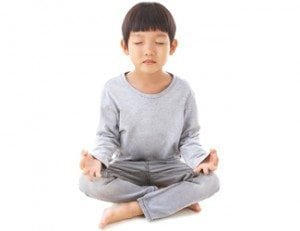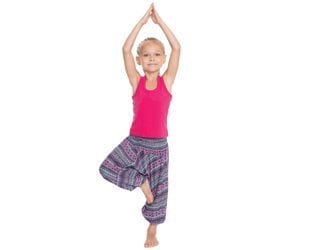Mindful Minutes for Little Ones
Yoga Helps Kids Focus and Relax
American kids’ school, after-school and weekend schedules now rival the hectic pace of their multitasking parents. Like their adult counterparts, youngsters need time to decompress from the pressures of life and be present in their own skin, and yoga provides the tools to accomplish this.
Most adults take to their yoga mat to create harmony in their body and mind, increase flexibility and balance, build muscle tone and strength, and because it makes them feel great. These same benefits apply to children as their developing bodies and minds respond to yoga on a deep level, both on and off the mat.
Start with Watching Breath
“Breathing and mindfulness practices are important for children,” explains Mariam Gates, the Santa Cruz, California, creator of the Kid Power Yoga Program and author of Good Morning Yoga and the upcoming Good Night Yoga. “There is so much that children are not in control of in their everyday lives; to give them a way to physically process their experience, to self-soothe and find their own internal source of strength, is crucial.”
“Having kids experience simply paying attention to their breath as it comes all the way in and moves all the way out can serve them well in every area of their lives going forward,” says Gates. In the classroom, it transfers to learning skills benefited by the ability to focus.
From toddlers to teens, children can have a difficult time processing and controlling their emotions, which are vital life skills. Carla Tantillo, founder of Mindful Practices, a Chicago-area wellness organization, has found that yoga and the practice of mindfulness help children express themselves in constructive ways. She observes, “In any situation, especially in communities where reactivity, impulsiveness and violent solutions are modeled, yoga empowers children to pause and take a breath so they can own what’s happened, move through it and move on.”
“I like yoga because it makes me feel like there is calm all around me,” says 8-year-old Biko Cooper.
Dee Marie, the Boulder, Colorado, founder and executive director of Calming Kids, a nonprofit program that integrates yoga into the classroom to foster a nonviolent atmosphere, says, “When a child learns through yoga how to feel a sense of themselves and begins to understand their self-worth and stand tall in their power, they can begin to regulate their breath and their emotions.”
These invaluable skills stay with children through adulthood.
Step into Yoga Together
 Educators are starting to take notice of yoga’s benefits for children, including those with attention deficit disorders or autism, but yoga practice is still rare among school-age children. As encouragement, “Make it fun,” advises Gates. “It’s essential to create experiences that feel accessible and enjoyable for kids. They must feel empowered to do it themselves and take over the experience.”
Educators are starting to take notice of yoga’s benefits for children, including those with attention deficit disorders or autism, but yoga practice is still rare among school-age children. As encouragement, “Make it fun,” advises Gates. “It’s essential to create experiences that feel accessible and enjoyable for kids. They must feel empowered to do it themselves and take over the experience.”
Six-year-old Carmen Wheeler likes doing yoga with her dad. “Yoga gets me feeling strong and it really calms me down,” she says. Music can help children relax and focus during their practice. Soothing basic instrumentals are good to start; an Internet search for yoga music for kids reveals many options.
Parents can assist by incorporating yoga into a child’s daily bedtime ritual. “Do whatever they are willing to do with them,” counsels Marie. “Start by lying on the bedroom floor, doing stretches and focusing on breathing. Then move to the bed and teach some relaxation and visualization techniques.”
Marie cautions parents against insisting that their child’s yoga practice mirror their own. “We have to meet children where they are.” Adults think that yoga has to look a certain way, but sometimes children don’t necessarily want to do the postures we’re familiar with. The best teaching reaches each individual child in a way that resonates with them because yoga is a lifestyle, not an exercise regimen,” she says. Yoga novices and parents that prefer specific guidance can take advantage of local studio classes for children and families or use DVDs, online streaming services and instruction books.
Kevin Day, age 5, regularly starts his days with a Boat pose. “I like it because you can do it with a friend,” he says.
Lisa Flynn, the Dover, New Hampshire, founder and chief executive officer of ChildLight Yoga and Yoga 4 Classrooms, is optimistic about the future. “In 10 years, I envision social and emotional learning, yoga, and mindfulness integrated at every school and mandated by educational policy,” she says. In addition to improved physical, social, emotional and cognitive health and wellness of the students, teachers and parents, she foresees “a positive shift in the overall school climate.”
Julianne Hale is a freelance writer and Natural Awakenings franchise magazine editor in Cleveland, TN.
Cultivating Mindfulness in the Classroom
BY JULIANNE HALE
When Scott Frauenheim, director of the Chicago International Charter School  (CICS) West Belden, noticed that some students in his kindergarten through eighth grade urban classrooms were not fully engaged, he decided to focus the 2014-2015 school year on mindfulness for both students and faculty. He enlisted the help of Mindful Practices, a Chicago-based school wellness organization founded by Carla Tantillo.
(CICS) West Belden, noticed that some students in his kindergarten through eighth grade urban classrooms were not fully engaged, he decided to focus the 2014-2015 school year on mindfulness for both students and faculty. He enlisted the help of Mindful Practices, a Chicago-based school wellness organization founded by Carla Tantillo.
Using the strategies Tantillo recommends in her book Cooling Down Your Classroom, teachers were taught to involve students in mindful minutes—short bursts of simple yoga poses, breathing exercises and other techniques—to cultivate mindfulness. The initiative proved to be powerful and helpful, explains Frauenheim. “Soon students were able to identify areas of personal need throughout the day and cultivate mindfulness within themselves using what they learned.”
The program concluded last year, but CICS West Belden teachers and students continue to use designated time to practice mindfulness in the morning and as a classroom mental reset when they notice that students are distracted or unfocused during the day. Mindful Practices’ innovative programs have achieved similar success in other elementary, middle and high schools in the Chicago area.





























